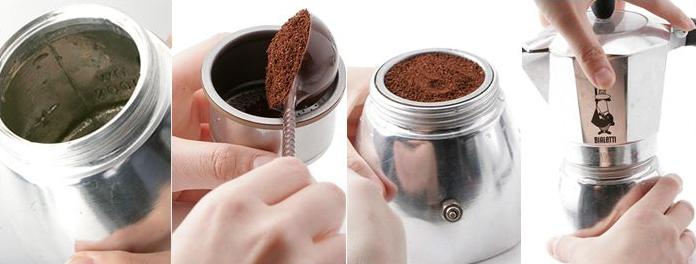 Loading... Please wait...
Loading... Please wait...Categories
Our Newsletter
- Home
- Making coffee using a stove top espresso maker
Making coffee using a stove top espresso maker
Posted on 7th Jun 2012 @ 3:40 PM
from Fantes

The stovetop espresso maker, also known as "macchinetta", is still the most popular way of making espresso at home.
It works by creating pressure through heat to force water through finely ground coffee and into a serving chamber.
How much is 1 cup? A traditional espresso is about 1.5 ounces. A 6-cup espresso maker would thus make approximately 9 oz. of that delicious liquid. Though espresso cups may hold 3 to 4 oz., it is customary to only partly fill the cup.
Become familiar with the parts of your macchinetta. Take it apart and examine how each part fits in place before you wash and use it the first time.
How to make espresso in a macchinetta:
- Fill the bottom chamber with cold water up to the steam release valve (overpressure plug).
- Insert the funnel filter (cone) and fill it with espresso-ground coffee, smoothing it without tamping.
- Make sure the flat round filter plate and the rubber gasket are in place underneath the central column of the upper part of the macchinetta.
- Screw the top on, but not too hard.
- Put it on the stovetop with enough heat to cover the bottom, but not so that it heats the handle.
- When you hear the macchinetta gurgling, remove it from the heat and allow it to sit for 30 seconds.
- Use a spoon to stir the coffee, then serve.
The Overpressure Plug (emergency steam release valve) is a safety mechanism that will open a way for the steam to escape if it can't go through tamped coffee grounds. It usually lasts the life of the pot. To help insure this, do not tamp the coffee grounds. Smooth the coffee, instead, then lightly knock the filter funnel downwards on a counter to help evenly distribute the grounds.
Metal handles and surfaces get hot, so use a pot holder when handling a macchinetta. Close supervision is necessary when using a macchinetta, especially when children are near.
Metal handles and surfaces get hot, so use a pot holder when handling a macchinetta. Close supervision is necessary when using a macchinetta, especially when children are near.
Keep the heat source low and under the pot to help prevent discoloration and damage to the handle and other parts. Over time, some discoloration of the metal is to be expected due to the repetitive heating and to the natural effects from your water supply. Some heat spots (bluing) can be cleaned using silver polish on the stainless steel macchinetta. On a smaller macchinetta, just keep the handle away from the heat source, even if the macchinetta is not perfectly centered on the heat. The use of a diffuser will keep the heat lower, though it will take a bit longer for the macchinetta to heat.
To maintain the macchinetta in good condition, wash all the parts with hot sudsy water, and rinse thoroughly. (Make sure the filter funnel holes are not clogged as well.) Before first use, and regularly (though not necessarily every time), also remove and wash the rubber gasket and round flat filter plate. Use a dull knife point, or small screwdriver, to remove the gasket, and to get to the filter plate. When the gasket dries or cracks, replace it. A telltale sign of a needed replacement gasket will be that some steam will begin to escape from the screw threads between the top and bottom pieces of your macchinetta.
Occasionally scour the inside of the macchinetta to remove mineral deposits. Or soak with a solution of equal parts white vinegar and water, then rinse thoroughly.
Gaskets are likely to last at least a year if they are cleaned on a regular basis. Keep a note of the name of the manufacturer of the espresso maker, its model name and size; this will help in obtaining replacement gaskets. If you can't find a replacement, get a sheet of rubber in a similar thickness (from your local hardware or plumbing supply store), and use the old gasket to cut out a template on the sheet of rubber.

| ESPRESSO CUP SIZE CONVERSION CHART | ||
| Espresso Size | Metric Equivalent | Standard Equivalent |
| 1 Cup | 59 ml | 2oz. - ¼ Cup |
| 2 Cup | 118 ml | 4oz. - ½ Cup |
| 3 Cup | 177 ml | 6oz. - ¾ Cup |
| 4 Cup | 237 ml | 8oz. - 1 Cup |
| 6 Cup | 354 ml | 12oz. - 1½ Cup |
| 9 Cup | 531 ml | 18oz. - 2¼ Cups |
| 10 Cup | 590 ml | 20oz. - 2½ Cups |
| 12 Cup | 711 ml | 24oz. - 3 Cups |
